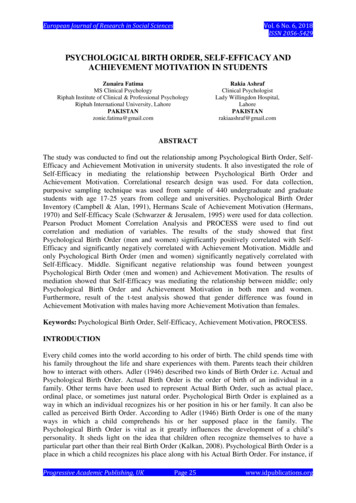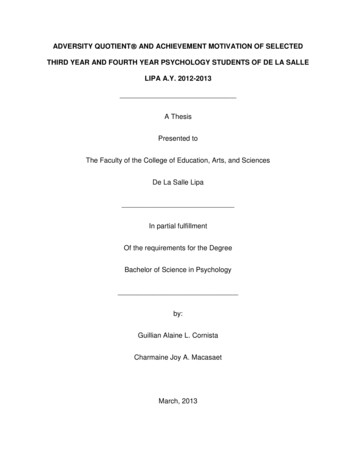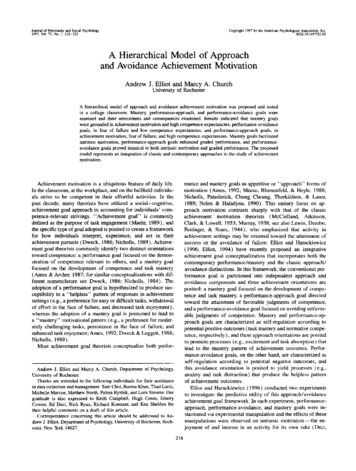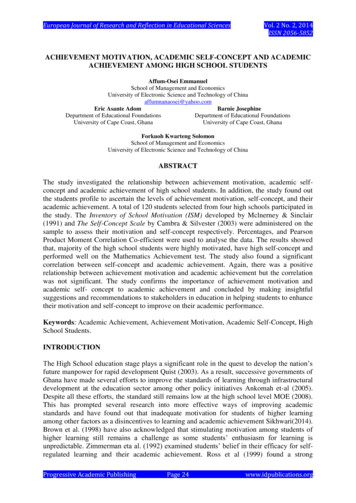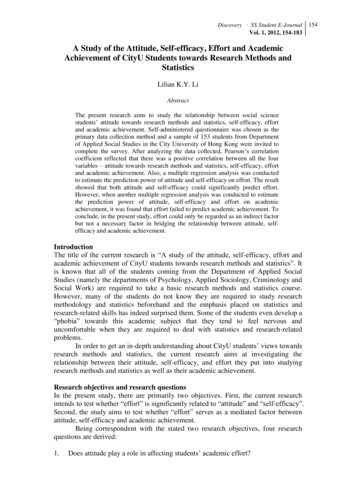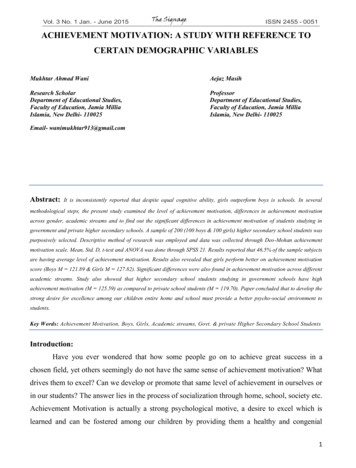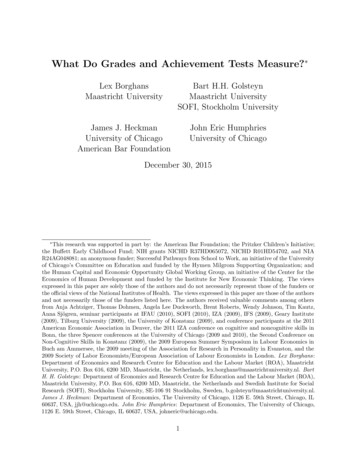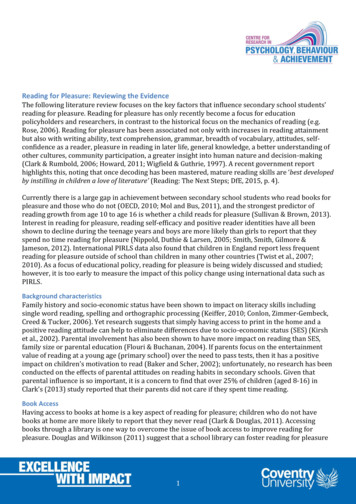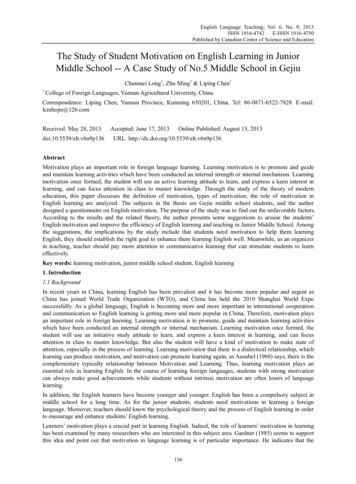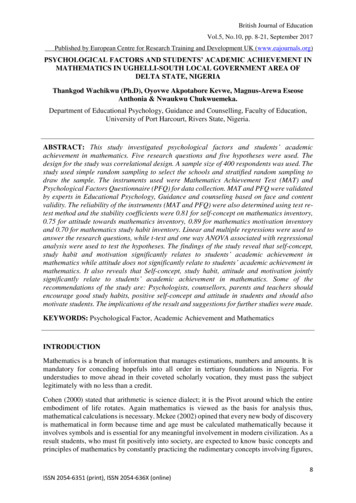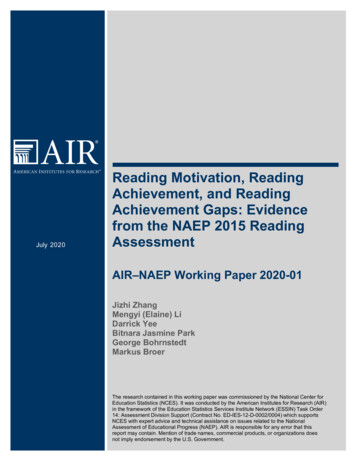
Transcription
July 2020Reading Motivation, ReadingAchievement, and ReadingAchievement Gaps: Evidencefrom the NAEP 2015 ReadingAssessmentAIR–NAEP Working Paper 2020-01Jizhi ZhangMengyi (Elaine) LiDarrick YeeBitnara Jasmine ParkGeorge BohrnstedtMarkus BroerThe research contained in this working paper was commissioned by the National Center forEducation Statistics (NCES). It was conducted by the American Institutes for Research (AIR)in the framework of the Education Statistics Services Institute Network (ESSIN) Task Order14: Assessment Division Support (Contract No. ED-IES-12-D-0002/0004) which supportsNCES with expert advice and technical assistance on issues related to the NationalAssessment of Educational Progress (NAEP). AIR is responsible for any error that thisreport may contain. Mention of trade names, commercial products, or organizations doesnot imply endorsement by the U.S. Government.
Reading Motivation, Reading Achievement, andReading Achievement Gaps: Evidence from theNAEP 2015 Reading AssessmentAIR–NAEP Working Paper #2020-01July 2020Jizhi ZhangMengyi (Elaine) LiDarrick YeeBitnara Jasmine ParkGeorge BohrnstedtMarkus Broer1000 Thomas Jefferson Street NWWashington, DC 20007-3835202.403.5000www.air.orgCopyright 2020 American Institutes for Research. All rights reserved.
AIREstablished in 1946, with headquarters in Washington, D.C., the American Institutes for Research (AIR) is anonpartisan, not-for-profit organization that conducts behavioral and social science research and delivers technicalassistance both domestically and internationally in the areas of health, education, and workforce productivity. Formore information, visit www.air.org.NCESThe National Center for Education Statistics (NCES) is the primary federal entity for collecting and analyzing datarelated to education in the U.S. and other nations. NCES is located within the U.S. Department of Education and theInstitute of Education Sciences. NCES fulfills a Congressional mandate to collect, collate, analyze, and reportcomplete statistics on the condition of American education; conduct and publish reports; and review and report oneducation activities internationally.ESSINThe Education Statistics Services Institute Network (ESSIN) is a network of companies that provide the NationalCenter for Education Statistics (NCES) with expert advice and technical assistance, for example in areas such asstatistical methodology; research, analysis and reporting; and Survey development. This AIR-NAEP working paper isbased on research conducted under the Research, Analysis and Psychometric Support sub-component of ESSINTask Order 14 for which AIR is the prime contractor.William Tirre, a Program Director in the NCES Assessment Division, oversees the Research, Analysis andPsychometric Support sub-component of ESSIN Task Order 14.Suggested citation:Zhang, J., Li, M., Yee, D., Park, B. J., Bohrnstedt, G., & Broer, M. (2020). Reading Motivation, Reading Achievement,and Reading Achievement Gaps: Evidence from the NAEP 2015 Reading Assessment [AIR-NAEP Working Paper#2020-01]. Washington, DC: American Institutes for Research.For inquiries, contact:Jizhi Zhang, Principal ResearcherEmail: jizhizhang@air.orgMarkus Broer, Project Director for Research under ESSIN Task 14Email: mbroer@air.orgMary Ann Fox, AIR Vice President and Project Director of ESSIN Task 14Email: mafox@air.org
Executive SummaryMotivation is a central topic in educational psychology. A multitude of studies have shown thatstudents’ motivation affects their learning behaviors and ultimately their learning outcomes—i.e., academic achievement—even after taking into account students’ cognitive ability, previousacademic achievement, and other demographic and social characteristics (Schunk, Pintrich, andMeece 2008; Wigfield et al. 2006; Zhang et al. 2017; Bohrnstedt et al. 2020). Student learninglargely relies on processing and ultimately comprehending written materials which highlights theimportance of reading for students’ academic success. Hulme and Snowling (2013) suggest that“learning to read is a key objective of early education and difficulties in learning to read haveserious adverse consequences.” Proficient reading skills play a significant role in students’success in every academic domain (Guthrie et al. 2000; Schiefele et al. 2012). Therefore, readingis considered a precursor to students’ academic achievement, and fostering students’ motivationto read is a key issue for educators.National assessment data on reading performance are concerning in that they indicate that manyof the nation’s students are not doing well in reading. For example, in 2017, the NationalAssessment of Educational Progress (NAEP) 1 found that roughly two thirds of 4th and 8th gradestudents performed below the NAEP Proficient achievement level in reading (63 percent and 64percent, respectively). Furthermore, 32 percent of 4th grade students and 24 percent of 8th gradestudents performed below the NAEP Basic achievement level, indicating that many students arestruggling to master even fundamental reading skills.Differences in reading performance by student subgroups are concerning as well. Theachievement gaps between White and Black students and between White and Hispanic studentsare substantial. For example, the percentage of White 8th graders who scored at or above theNAEP Proficient achievement level in reading in 2017 (45 percent) was double the percentagesof Black (18 percent) and Hispanic (23 percent) students performing at or above NAEPProficient. In addition, 16 percent of White 8th graders performed below the NAEP Basicachievement level in reading in 2017, while the percentages of Black and Hispanic 8th gradersscoring below NAEP Basic were 40 and 33 percent, respectively.Understanding the relationship between reading motivation and reading achievement helps shedlight on the underlying psychological processes affecting students’ reading behavior andachievement which in turn can inform classroom instructional practices to promote students’reading motivation. Although many studies demonstrate the importance of reading motivation onreading achievement, several gaps in the research literature remain. For instance, most of theliterature on reading motivation focuses on students in elementary school and less frequently onstudents in middle school (Gottfried et al., 2001; Kelley and Decker 2009). Additionally, manyreading motivation studies are based on relatively small sample sizes decreasing thegeneralizability of results. Also, the effects of reading motivation in many studies are tarnishedby the influences of confounding variables (e.g., student socioeconomic status (SES), student1NAEP is the largest nationally representative assessment of U.S. students’ performance in a variety of academic subjects,including reading, mathematics, science, and social studies.i
cognitive abilities) (Schiefele et al. 2012) rendering it difficult to identify the independent effectof reading motivation on reading achievement.This study aims to understand the role that reading motivation plays in middle school readingachievement (including achievement gaps) by analyzing the 2015 grade 8 NAEP reading data.The current study focuses on identifying the unique effects of student-level reading motivationand aggregated school-level mean reading motivation on reading achievement. Hierarchicallinear modeling is used to partition variability in student reading achievement into within- andbetween-school components after student- and school-level demographic variables are taken intoaccount. In addition, this study investigates whether the identified unique effects of readingmotivation on reading achievement vary by gender, race/ethnicity, English language learnerstatus (ELL), and other demographic variables. Finally, the study examines the roles thatstudents’ demographic characteristics and reading motivation play in understanding readingachievement gaps based on students’ race/ethnicity and ELL status,A summary of the results and discussions of the findings are presented below: The analyses indicated that student reading motivation is substantially associated withstudent reading achievement even after taking into account student gender, race/ethnicity,and SES, ELL, Individualized Education Program (IEP) statuses, and interaction terms.Each unit difference in student reading motivation (reading motivation scale rangingfrom 0 to 3) was predicted to result in a 10.67-point difference in NAEP reading scores,which is approximately one third of a standard deviation. Another important finding of the current study is the unique and substantial effect ofschool-level mean motivation on school mean reading achievement even in the presenceof other school demographic variables including mean school-level SES, proportion ofracial/ethnic minority students, and proportion of IEP students. The estimated coefficientfor school mean motivation suggests that for each unit difference in school meanmotivation, there is a predicted 17-point difference in school mean reading achievementwhich is about half of one standard deviation. This result highlights a school levelcontextual effect as well. That is, the reading motivation of one’s peers in school matterssubstantially as well. Schools might be able to promote students’ academic developmentnot only directly through effective teaching but also indirectly through a school climatethat fosters reading motivation. Variables identified in the HLM model were able to explain a substantial amount of thereading achievement gap between White and Black students, but not all of it. The originalachievement gap between White and Black students was 25 points (0.74 SD units) forreading achievement. After taking into account student reading motivation, studentdemographic variables, and the interaction terms, the remaining unexplained achievementgap was 11 points (0.32 SD units), which is still statistically significant but substantiallysmaller than the observed reading gap.ii
The achievement gap between White and Hispanic students was 20 points, which is 0.64standard deviation (SD) units, before taking into account other explanatory variables.After accounting for student reading motivation, student demographic variables, and theinteraction terms, the remaining unexplained achievement gap was less than 1 point andno longer statistically significant. The observed achievement gap between ELL and non-ELL students was 43 points (1.26SD units). After taking into account student motivation and social demographicbackground, ELL students scored 20 NAEP points (0.60 SD units) lower compared tonon-ELL students. Also, this study investigated interactions among motivation, studentELL status, and being Hispanic students. The NAEP reading scores for white andHispanic students after taking into account their ELL status and their socio-demographicbackgrounds were not statistically different. This suggests that the reading achievementgap between white and Hispanic students is largely due to differences between ELL andnon- ELL students rather than being Hispanic. The interaction between ELL status and reading motivation was statistically significant:specifically, the effect of motivation on reading achievement was substantially weaker forELL students than for non-ELL students. Overall, students having a higher level ofreading motivation on average were more likely to do well on a reading achievementassessment than those with lower reading motivation. However, for ELL students, theeffects of motivation seem muted apparently due to the absence of a strong grasp of theEnglish language.The current study results found that student reading motivation is substantially associated withstudent reading achievement, even after taking into account student gender, race/ethnicity, andSES, ELL, IEP statuses, and interaction terms, which comports with the literature on the effectsof reading motivation on reading achievement. In addition, the current study identifies the uniqueand substantial effect of school-level mean motivation on school mean reading achievement evenin the presence of other school demographic variables, which highlights the significant roleschools might have on promoting students’ academic development.iii
ContentsIntroduction . 1Theoretical Background . 2Intrinsic and Extrinsic Reading Motivation . 3The Effect of Reading Motivation on Reading Achievement . 4Effects of Reading Motivation on Reading Achievement across Student Subgroups . 5Gender, reading motivation, and reading achievement . 5Race/ethnicity, reading motivation, and reading achievement . 6Social Context, Motivation, and Achievement . 7Methods. 8Data . 8Variables used in the HLM analysis . 12Student-level variables . 13School-level variables . 14Outcome variables . 15Analysis . 15Hierarchical Linear Modeling . 15Centering . 18Weighting . 18Homogeneity assumptions in HLM . 19Results . 19Descriptive statistics for NAEP reading achievement and reading motivation . 19HLM results . 21Discussion . 29Student reading motivation and school-level mean motivation on reading achievement . 29Reading motivation and achievement gaps . 30White-Hispanic achievement gap . 30ELL-non-ELL achievement gap . 31White- Black achievement gap . 32Limitations . 32References . 34Appendix A. Items in the construction of the SES index and their coding . A-1Appendix B: The scatter plot of individual school residuals of NAEP reading plausiblevalues . B-1Appendix C: The plot of level-1 residuals against fitted values of NAEP reading plausiblevalues . C-1Appendix D. Correlations among student-level variables . D-1iv
Appendix E. Correlations among school level variables .E-1Appendix F. An expression example of interpreting the Hispanic-White achievement gapby motivation. . F-1Appendix G. Summary of results from hierarchical linear models (HLM): Studentmotivation treated as random effects variable . G-1List of TablesTable 1. Basic demographic characteristics for the final analytic sample . 9Table 2. Comparison of the final analytic sample with the 2015 grade 8 public schoolsample, by student subgroups . 10Table 3. Reading achievement comparison of the final analytic sample with the NAEPpublic school sample on the 2015 NAEP grade 8 assessment, by operational populationstudent subgroups. 11Table 4. Comparison of the final analytic sample with the 2015 grade 8 public schoolpopulation, by school characteristics . 12Table 5. Confirmatory factor analysis of NAEP reading motivation items. 14Table 6. Reading achievement by student demographic variables . 20Table 7. Reading motivation by student demographic variables . 21Table 8. Summary of results from hierarchical linear models (HLM) . 23List of FiguresFigure 1. Predicated NAEP reading score based on student motivation level, Hispanic andELL status . 27v
IntroductionMotivation is a central topic in educational psychology. A multitude of studies have shown thatstudents’ motivation affects their learning behaviors and ultimately their learning outcomes—i.e.,academic achievement—even after taking into account students’ cognitive ability, previousacademic achievement, and other demographic and social characteristics (Schunk, Pintrich, andMeece 2008; Wigfield et al. 2006; Zhang et al. 2017; Bohrnstedt et al. 2020). Student learninglargely relies on processing and ultimately comprehending written materials which highlights theimportance of reading for students’ academic success. Hulme and Snowling (2013) suggested that“learning to read is a key objective of early education and difficulties in learning to read haveserious adverse consequences.” Proficient reading skills play a significant role in students’ successin every academic domain (Guthrie et al. 2000; Schiefele et al. 2012). Therefore, reading isconsidered a precursor to students’ academic achievement, and fostering students’ motivation toread is a key issue for educators.Unfortunately, national assessment data on reading performance are concerning. The NationalAssessment of Educational Progress (NAEP) assesses student performance in reading at grades 4,8, and 12 in both public and private schools every two years across the nation.1 NAEPachievement levels define what students should know and be able to do: NAEP Basic indicatespartial mastery of fundamental skills, and NAEP Proficient indicates demonstrated competencyover challenging subject matter. In 2017, roughly two thirds of 4th and 8th grade studentsperformed below the NAEP Proficient achievement level in reading (63 percent and 64 percent,respectively). Furthermore, 32 percent of 4th grade students and 24 percent of 8th grade studentsperformed below the NAEP Basic achievement level, indicating that many students are strugglingto master even fundamental reading skills.Differences in reading performance by student subgroups are concerning as well. The achievementgaps between White and Black students and between White and Hispanic students are substantial.For example, the percentage of White 8th graders who scored at or above the NAEP Proficientachievement level in reading in 2017 (45 percent) was double the percentages of Black (18percent) and Hispanic (23 percent) students performing at or above NAEP Proficient. In addition,16 percent of White 8th graders performed below the NAEP Basic achievement level in reading in2017, while the percentages of Black and Hispanic 8th graders scoring below NAEP Basic were 40and 33 percent, respectively.Understanding the relationship between reading motivation and reading achievement helps shedlight on the underlying psychological processes affecting students’ reading behavior andachievement and may inform classroom instructional practices to promote students’ readingmotivation. Although many studies demonstrate the importance of reading motivation on readingachievement, several gaps in the research literature remain. For instance, most of the literature onreading motivation is about students in elementary school, and less frequently focuses on studentsin middle school (Gottfried et al. 2001; Kelley and Decker 2009). Additionally, many readingmotivation studies are based on relatively small sample sizes, decreasing the generalizability of1NAEP is the largest nationally representative assessment of U.S. students’ performance in a variety of academic subjects,including reading, mathematics, science, and social studies.1
results. Also, the effects of reading motivation in many studies are tarnished by the influences ofconfounding variables (e.g., student SES, student cognitive abilities) Schiefele et al. 2012),rendering it difficult to identify the independent effect of reading motivation on readingachievement.This study aims to understand the role that reading motivation plays in middle school readingachievement (including achievement gaps) by analyzing the 2015 grade 8 NAEP reading data.The current study focuses on identifying the unique effects of student-level reading motivationand aggregated school-level mean reading motivation on reading achievement. Hierarchicallinear modeling is used to partition variability in student reading achievement into within- andbetween-school components after student- and school-level demographic variables are taken intoaccount. In addition, this study investigates whether the identified unique effects of readingmotivation on reading achievement vary by gender, race/ethnicity, English language learnerstatus (ELL), and other demographic variables. Meanwhile, the current study strives tounderstand the reading achievement gaps based on students’ race/ethnicity and ELL status. Thestudy examines how students’ demographic characteristics and reading motivation explainWhite-Black, White-Hispanic, and ELL and non-ELL students’ achievement gaps. To achievethese aims this study addresses the following six research questions:1. Is reading motivation significantly associated with NAEP reading achievement?2. Does the association between reading motivation and reading achievement persist evenafter student social demographic characteristics are taken into account?3. Does the association investigated in research question 2 between motivation andachievement vary by gender, race/ethnicity, socioeconomic status, English languagelearner status, and individualized education program status? In addition, does theassociation vary across schools? How are student-level characteristics includingmotivation and demographics helping to explain White-Black, White-Hispanic and ELLnon-ELL students’ achievement gaps?4. Does school-level mean reading motivation explain school-level variation in studentreading achievement?5. Do school-level characteristics (social demographics) explain school-level variation instudent reading achievement?6. Do school-level characteristics help explain the association between student readingmotivation and NAEP reading scores?Theoretical BackgroundMotivation can be thought of as the driver or energy expended in pursuit of a goal (readingachievement in this study). It can either be extrinsic (based on actual or perceived rewards orpunishments) or intrinsic (based on internalized beliefs and values about the importance ofachieving the goal) (Deci 1975). More generally, motivation has been defined as “the processwhereby goal-directed activity is instigated and sustained” (Pintrich and Schunk 2002, p. 5).2
Because one cannot directly observe this internal, latent process, a theoretical framework isnecessary for measuring motivational beliefs. And as noted by Lameva and Choneteva (2013):“Due to the latency of psychological constructs, the construct motivation can be conceptualizedin different ways, with different theories focusing on different psychological processes.” (p. 4)Contemporary literature on achievement motivation is grounded in a social cognitiveperspective, focusing on understanding students’ cognitive process of whether they choose toengage in learning tasks and how persistent they are while working on those tasks. Centralmotivational beliefs include individuals’ competence-related beliefs such as self-efficacy andsubjective values (Eccles and Wigfield 2002). Competence-related beliefs refer to beliefs aboutindividuals’ current and future perceptions of the confidence they have of how well they can orwill perform different tasks and activities currently or in the future; values refer to incentives orreasons for undertaking the task or activity. More specifically, motivational theories address twoquestions: (1) Can I do the task? and (2) Why am I doing the task? For example, in the domain ofreading, competence-related beliefs address individuals’ beliefs on whether they can do well inreading. Values explain why individuals want to read or take on more challenging reading topics,or participate in other reading activities like book clubs.Also, academic motivation is subject specific. In the domain of reading motivation, defined “asthe individual's goals and beliefs with regard to reading” (Guthrie and Wigfield 1999), the focalpoint is the second question—why students engage in reading and related activities. Morespecifically, reading motivational theorists distinguish intrinsic and extrinsic motivation toexplain students’ reading behaviors and related reading achievement outcomes (e.g., reading testscores and reading skills) (Schiefel et al. 2012). Intrinsic motivation arises from students’ ownself-expressed interests, and extrinsic motivation is from outside influences such as teacher andparent expectations, perceived rewards, and grades.Modern motivation theories not only consider motivation as an individual characteristic, but alsoacknowledge the important impacts of social context and interpersonal relations on motivation.The current study uses a modern motivational framework to conceptualize reading motivationand its impacts on reading achievement. Intrinsic and extrinsic reading motivation beliefs are themajor components investigated in this study. Student family and school background variables areincluded to capture the social context so as to better understand the relationships between readingmotivation and achievement.Intrinsic and Extrinsic Reading MotivationThe most widely known line of research in reading motivation pertains to the distinction betweenintrinsic and extrinsic motivation. Intrinsic motivation is defined as “the willingness to readbecause that activity is satisfying or rewarding in its own right Extrinsic motivation refers toreasons for reading that are external to both the activity of reading and the topic of the text”(Schiefel et al. 2012, p. 429). In other words, students with high intrinsic reading motivation areactively engaged in reading or reading-related activities due to the pure pleasure and enjoymentthat arise from reading. However, students with high extrinsic reading motivation participate inreading or reading-related activities for reasons not inherent in the reading itself—instead theydo it for reasons such as earning a reward. For example, a middle school student may bemotivated to read because of his/her interest or curiosity in a particular topic, making their3
motivation intrinsic. While a student who reads to complete a school assignment or to get highscores in a particular subject is extrinsically motivated.Researchers have conducted both qualitative and quantitative studies to investigate thedimensions of intrinsic and extrinsic reading motivation. Although there is not unanimousagreement on the specific dimensions of intrinsic and extrinsic reading motivation, many readingmotivation theorists agree that intrinsic reading motivation includes the dimensions of curiosity,enjoyment/interest, and involvement; that is, they focus on incentives within the reading processitself (Wigfield and Guthrie 1997; Guthrie and Wigfield, 199
Motivation is a central topic in educational psychology. A multitude of studies have shown that students' motivation affects their learning behaviors and ultimately their learning outcomes— i.e., academic achievement—even after taking into account students' cognitive ability, previous
